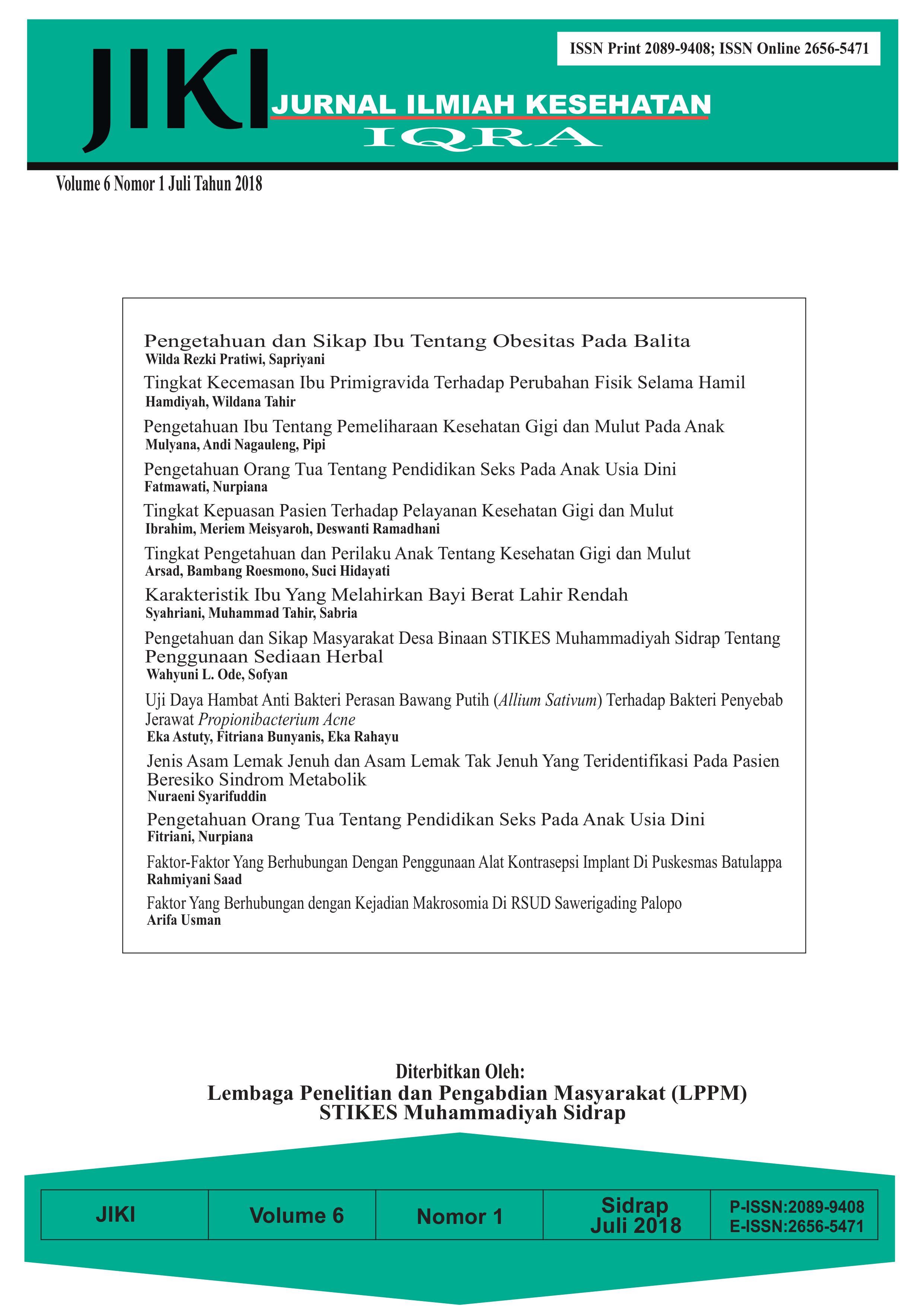JENIS ASAM LEMAK JENUH DAN ASAM LEMAK TAK JENUH YANG TERIDENTIFIKASI PADA PASIEN BERISIKO SINDROM METABOLIK
Jurnal Ilmiah Kesehatan Iqra
Abstract
Risiko sindrom metabolik (SM) adalah salah satu dari kriteria dari SM seperti dislipidemia, peningkatan tekanan darah atau hipertensi, peningkatan kadar glukosa plasma, dan proinflamasi. Adanya hubungan saturated fatty acid (SFA), monounsaturated fatty acid (MUFA) dan polyunsaturated fatty acid (PUFA) dengan sensitivitas insulin, tekanan darah, plasma lipid dan inflamasi.Tujuan dari penelitian ini adalah untuk mengetahui jenis SFA, MUFA dan PUFA pada pasien berisiko SM. Metode penelitian ini bersifat analisis observasional dengan rancangan cross sectional design. Peneliti melibatkan dokter dalam pemilihan pasien yang akan terlibat dalam penelitian dan diperoleh total subjek penelitian sebanyak 99 pasien berisiko SM. Pengisian informed consent dan pengambilan darah diambil dari vena kubitus relawan sebanyak 10 ml oleh tenaga analis yang sudah terlatih. Prosedur pemeriksaan jenis SFA, MUFA dan PUFA dilakukan dengan metode gas chromatography–mass spectrometry (GC-MS). Hasil dianalisis menggunakan uji statistik univariat dengan taraf kepercayaan 95%. Hasil penelitian menunjukkan Jenis SFA adalah capric acid, lauric acid, pentadecanoic acid, palmitic acid, leptadecanoic acid, stearic acid, arachidic acid, behenic acid, lignoceric acid, jenis MUFA adalah palmitoleic acid, oleic acid dan jenis PUFA adalah linoleic acid, linolenic acid pada pasien berisiko sindrom metabolik.
References
Calder PC: n-3 polyunsaturated fatty acids, inflammation, and inflammatory diseases. Am J Clin Nutr 2006, 83(6 Suppl):1505-1519. 12.
Dijk van S.J., E.J.Freskens, M.B. Bos, D.W. Hoelen, R. Heijligenberg, M.G. Bromhaar, L.C. de Groot, J.H. de Vries, M. Mullen, L.A. Afman..2009. A Saturated Fatty Acid-Rich Diet Induces an Obesity-Linked Proinflammatory Gene Expression Profile In Adipose Tissue of Subjects at Risk of Metabolic Syndrome. The American Journal of Clinical Nutrition 90(6):1656-64.
Gabriel. M.R, G., M.B. Azucena, S.F. Alejandra and M.H. Jorge. 2013. Association Between Metabolic Syndrome and Erythrocyte Fatty Acid Profile in Mexican Adolescents: A Trans Fatty Acid Approach. journal Biomedical & Life Science 4(9A):51-58.
Goldberg, Katz, 2007
R.J. Goldberg, J. KatzA meta-analysis of the analgesic effects of omega-3 polyunsaturated fatty acid supplementation for inflammatory joint pain
Pain, 129 (2007), pp. 210-223
Kawashima A, Sugawara S, Okita M, akahane T, Fukui K, Hashiuchi M, Kataoka C, Tsukamoto I. 2014. Plasma fatty acid composition, estimated desaturase activities, and intakes of energy and nutrient in Japanese men with abdominal obesity or metabolic syndrome. J Nutr Sci Vitaminol (Tokyo) 55: 400-406, 2009.
Kralova Lesna I, suchanek P, Brabcova E, Kovar J, Malinska H, Poledne R.2013. Effects of different types of dietary fatty acids on subclinical inflammation in humans. Physiol Res 62: 145-152.
Lottenberg Am, Afonso Mda S, Lavrador Ms, Machado Rm, Nakandakare Er. 2012. The role of dietary fatty acids in the pathology of metabolic syndrome. J Nutr Biochem 23: 1027-1040.
Klein-Platat C, Drai J, Oujaa M, Schlienger JL, Simon C. 2005. Plasma fatty acid composition is associated with the metabolic syndrome and low-grade inflammation in overweight adolescents. Am J Clin Nutr. 82:1178-84.
Novgorodtseva TP, Karaman YK, Antonyuk MV, Zhukova NV. 2009. The role of free and esterified fatty acids in pathogenesis of metabolic syndrome. Klin Med, 7(5):33-37.
Novgorodtseva TP, Ivanov EM, Antoniuk MV, Karaman YK, Zhukova NV, Iurenko AV. 2008. The composition of nonesterified fatty acids in patients with metabolic syndrome. Klin Lab Diagn, 10: 38-40. 13.
Mayneris-Perxachs J, Guerendiain M, Castellote Ai, Estruch R, Covas Mi, Fito M, Salassalvadó J, Martinez-Gonzales Ma, Aros F, Lamuela-Raventos Rm, Lopez-Sabater Mc, for premided study investigators. 2014. Plasma fatty acids composition, estimated desaturase activities, and their relation with the metabolic syndrome in a population at high risk of cardiovascular disease. Clin Nutr 33: 90-97.
Marangoni F, Novo G, Perna G, Perrone Fp, Pirelli S, Ceroti M, Querci A, Poli A. 2014. Omega-6 and omega-3 polyunsaturated fatty acid levels are reduced in whole blood of Italian patients with a recent myocardial infarction: the AGE-IM study. Atherosclerosis 232: 334-338.
Mecca et al, 2012. M.S. Mecca, F. Moreto, F.H. Burini, R.C. Dalanesi, K.C. McLellan, R.C. Burini Ten-week lifestyle changing program reduces several indicators for metabolic syndrome in overweight adults Diabetology Metabolic Syndrome, 4.
Paillard F, Catheline D, Duff Fl, Bouriel M, Deugnier Y, Pouchard M, Daubert Jc, Legrand P. 2008 Plasma palmitoleic acid, a product of stearoyl-CoA desaturase activity, is an independent marker of triglyceridemia and abdominal adiposity. Nutr Metab Cardiovasc Dis 18: 436-440.
Phinney S. D. 2005. Fatty acids, inflammation and metabolic syndrome. Am. J. Clin. Nutr. 82:1151–1152.
Poudyal et al. 2011. H. Poudyal, S.K. Panchal, V. Diwan, L.Brown Omega-3 fatty acids and metabolic syndrome: Effects and emerging mechanisms of action Progress in Lipid Research, pp. 372-387.
Rajaram, S., K. Burke, B. Connell, T. Myint and J. Sabate. 2001. Human Nutrition and Metabolism A Monounsaturated Fatty Acid–Rich Pecan-Enriched Diet Favorably Alters the Serum Lipid Profile of Healthy Men and Women. Journal of Nutrition 131(9):2275-2279.
Stanley et al, 2007. J.C. Stanley, R.L. Elsom, P.C. Calder, B.A. Griffin, W.S. Harris, S.A. Jebb, J.A. Lovegrove, C.S. Moore, R.A. Riemersma, T.A. SandersUK Food Standards Agency Workshop Report: The effects of the dietary n-6:n-3 fatty acid ratio on cardiovascular health.
Titov VN. 2002. Atherosclerosis as a pathology polien fatty acids. Biological bases pathogenesis,diagnostics, preventive and treatment of atherosclerosis. M: Altus; 750.
Lakka HM, Laaksonen DE, Lakka TA, Niskanen LK, Kumpusalo E, Tuomilehto J, Salonen JT. 2002. The metabolic syndrome and total and cardiovascular disease mortality in middle-aged men. JAMA 288: 2709–2716.
Van Dam RM, Willett WC, Rimm EB, Stampfer MJ, Hu FB. 2002 Dietary fat and meat intake in relation to risk of type 2 diabetes in men. Diabetes Care 25: 417–424.
Vareka T, Vecka M, Jirak R, Tvrzicka E, macasek J, Zak A, Zeman M.2012. Plasma fatty acid profile in depressive disorder resembles insulin resistance state. Neuro Endocrinol Lett 33 (Suppl 2): 83-86.
Warensjo E, Riserus U, Vessby B. 2005. Fatty acid composition of serum lipids predicts the development of the metabolic syndrome in men. Diabetologia 48: 1999-2005.
Warensjo E, Sundsrom J, Lind L, Vessby B.2006. Factor analysis of fatty acids in serum lipids as a measure of dietary fat quality in relation to the metabolic syndrome in men. Am J Clin Nutr 84: 442-448.



